After taking the image in the cellar and the one in the hallway at night, I had been thinking about which one to choose and also whether I was working according to the brief in the first place. I find planning difficult and always have to force myself to stick to plans as well! It’s hard to force ideas when it is not my normal way of getting them. My ideas often come up after having taken the first steps and are not executed in a linear way.
Anyway, I checked on Facebook what my fellow students thought about the two initial images I had worked on. Here are their responses:
Jayne Kemp I really like the image kelder en night-11
Holly Woodward I prefer the cellar image. It has more of a potential story, and is beautifully lit.
Kate Aston I like the cellar image. It reminds me of an Urbex version of Alice in Wonderland.
Dawn Langley I’m actually really torn between the two. I like the lighting and leading lines on the cellar but I wonder whether it is ‘constructed’ enough? I guess only your tutor may be able to answer that. I think I prefer the more psychological feel of the Flamingo and lean towards the version with slightly colder/blue tones.
Lynda Kuit I’m with Dawn on this one. I like the drama of the second one. There is a lot going on there too.
Leonie Broekstra-Pauw Thanks! I’m also wondering if it is constructed enough. I ended up only having half an hour there, so decided on the minimalist approach. But you’re right, it’s not really done the way it is supposed to.
Holly Woodward Can you go back again, Leonie? Use the images you have got already for preparation and planning, and then spend another half an hour there doing the final version, perhaps?
Leonie Broekstra-Pauw I actually think I should. I’ll check. It does need a bit more visual clues.
Dawn Langley That would be my thinking – maybe things you discard as you go into hiding like a trail of breadcrumbs.
Anne Bryson I don’t know context and narrative, so can’t comment on whether or not the cellar image is constructed enough. Of the two I do prefer it though as I feel it has the potential for more of a story. For one thing you have had more time to think it through even though you may not have had the time you wanted to develop it in the way you want. I really like your thinking about why the woman might find herself there and if you are able to negotiate more time and develop some of these ideas further I think it would work.
I do find the other image fascinating though and assume I am seeing the same face as you are. It looks quite scary to me, is that blood on his mouth? What has she done to him?
Leonie Broekstra-Pauw Haha, hadn’t even noticed that!
Morris Gallagher I prefer the shadow images – as they are constructed they fit well with the A5 brief which is also to communicate an idea of feeling which I think this does very well. What would help you is a clearer conceptual framework; for me it referenced ‘Plato’s cave’ – nothing is what it appears to be just and shadow, and the showing the ‘hidden’ aspect of the psyche; Hopwood, A. (2006). “Jung’s model of the psyche.” Retrieved May 2nd, 2015, from http://www.thesap.org.uk/jung-s-model-of-the-psyche. What does this say about the ‘hidden’ you rather than the ‘persona?’
Leonie Broekstra-Pauw Thanks for the insight!
Lynda Kuit You can research Pliny’s fable about the shadow as well: http://www.tau.ac.il/~kenaan/tracing.pdf
Andrew Fitzgibbon Thanks for sharing Leonie – particularly interesting for me as I’m in the early stages of thinking about the assignment; a potential location is the cellar below my house that used to be used as a butchery when it was a working farm. A very different feel to your cellar but nonetheless also a cellar! I think as someone else mentioned the post didn’t seem to suggest a strong conceptual framework or intention for the work, apart the mention of escaping the world. With that as a concept, could you add artefacts as signs, thereby making the image feel more constructed? While I like the second image, it doesn’t feel constructed to me – more of a chance shot, which I guess it was. Look forward to seeing you final work, whatever you decide upon!
Steve Middlehurst I very much like the cellar shot. It has a Gregory Crewdson feel to it. I agree with some of the comments above, maybe needs a very few extra props. Crewdson is all about psychological messages so his work might help suggest props or gestures that would create possible narratives here.
Leonie Broekstra-Pauw Thanks! I’m still pondering on which things to add, give it a happier feel or make it all even more depressing. It’s a fun assignment!
As you can see, there were different ideas on which image works best and some interesting suggestions on where to look further.
I agreed with the fact that the cellar image needed more narrative elements and that the shadow shot has potential, but might not be constructed enough. So I gave it a thought and realised that I did want to continue my work with the cellar image, but not change it. It does need visual clues, but I don’t like to make it all too obvious and really leave the image open for many different interpretations.
That evening at dinnertime we were talking about the movie ‘Wasteland’, a story about a community in a slum who builds pieces of art out of trash. I haven’t watched the movie yet, but was triggered by the idea of constructing a story with whatever you can find in your vicinity. Besides that, at that time there were numerous bats flying through our garden and I decided to go out and take a few images, see if I could get the bats in the photo and then try to construct an image with garbage.
While working, it got dark and I came up with the idea that I could use this image as a counterbalance to the cellar photograph and the shadow. Outside versus inside, dark versus light, natural environment versus a man made environment. Together the image could trigger a narrative that works in a circular way and let the viewers draw connections between the settings and make up their own narrative, without giving too many clues on what it might be about. Here are some of the images that I took:
As you can see, I also asked my husband to jump in, just to see how it would work in the narrative next to the cellar image. I realised that I wanted to keep the same person in both images, to stress the fact that both images were interconnected by thoughts and time. This is the image I finally choose to work with:
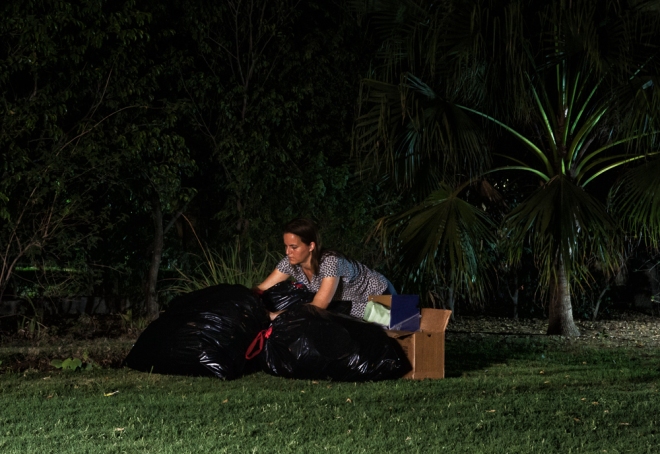
Besides bringing the images together, I wanted to give them a title that would trigger the narrative even more and enforce the story of what is taking place in the image. The story is non-linear and connects different moments and places. So the image in the cellar will have the title ‘The Thought’ and the one in the garden ‘The Proof’ and the photo in the hallway ‘The Possibility’
I came accross a photograph of Ellie Davies, where we see a man looking at a woman in a swimming pool at night. The atmosphere reminded me of the kind of atmosphere that I was trying to create in my cellar photograph. I looked up more of her work online and was struck by her artist statements and the way she is able to put her ideas into words. These are themes that I have tried to incorporate in my assignment as well. The first on how to construct an ‘imaginary Other’ and how different encounters and settings can combine the ‘progression of narrative‘ into a frame:
Ellie Davies’ Artist Statement on ‘After Dark’
These long format images explore the construction of an imaginary Other.
The encounters between the figures often leave one figure unaware of the other, drawing into the scenario a notion of the potentially voyeuristic nature of film and photography. These encounters may be real, or imagined by the characters.
These images are made by moving the camera sideways in increments along a linear trajectory, creating a series of images of the scene. These are blended together to form a seamless single frame that contains multiple perspective viewpoints and combines the filmic progression of narrative into a single frame.
A stage is constructed on which the narrative plays out.
In her series ‘Vantage Point’ Davies explores the dynamics between subjects and the spaces they occupy. In my set of images I want to show how spaces can trigger thoughts and contemplation that lead back to different spaces and memories. These memories may drive the subject to specific places for contemplation and isolation. I really like how Ellie Davies puts these themes into words.
Ellie Davies’ Artist Statement on ‘Vantage Point’
Set in homes, gardens and public areas these images explore the psychological relationships between the subjects and the spaces they occupy.
A dreamlike tension and sense of menace within the architectural or outdoor spaces plays into the dialogues between the people depicted. Drawing on everyday anxieties and childhood memories the images reflect on the fine line between reality and fantasy, exploring the strangeness that lurks beneath the surface of the commonplace. Night time and twilight settings distance the viewer from the everyday, entering a world of psychological uncertainty, where things are not always as they seem.
Familiar spaces are rendered peculiar by the night. The figures occupy pools of light which drop sharply away into a darkness which hints at the imagined unseen.
I would like to explore these psychological relationships between subjects and spaces as well. Can we trust our own memories, thoughts and experiences? Is what we have visually remembered true to what actually happened? Is the fact that there is an image of the memory proof of what had happened? What kind of feelings do memories evoke in specific places and why is the woman completely isolated, is that a result of what happened?
My fellow students pointed out two articles, one about the origin of painting, the function of shadow and its representation of reality, and an other article on the ideas of Jung about the individual, the conscious and subconsciousness. Both articled revealed more of the ideas that I would like to add to the images. How do we become aware of who we are, how does it relate to the reality we are in. I want my images to reflect this process of individuation:
Individuation
“Jung called the search for wholeness within the human psyche, the process of individuation. It may be described as a process of circumambulation around the Self as the centre of personality. The person aims to become conscious of him or herself as a unique human being, but at the same time, no more nor less than any other human being.If the tension between the opposites can be borne, then out
of this clash something new and creative can grow. In Jung’s view, this ‘something’ is a symbol which will contribute to a new direction which does justice to both sides of a conflict and which is a product of the unconscious rather than of rational thought.”
I would like the titles of the images to enforce the circular narrative that I want to create. This is what the final submission will look like:
References:






































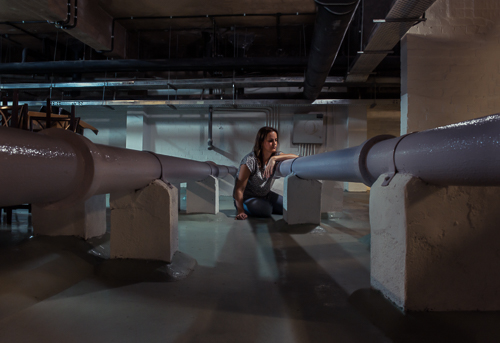
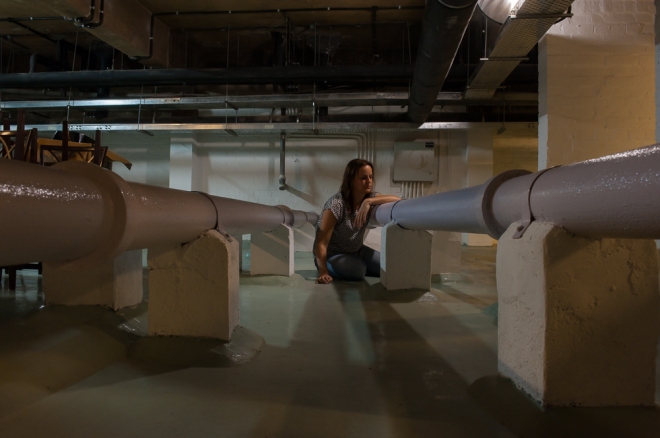
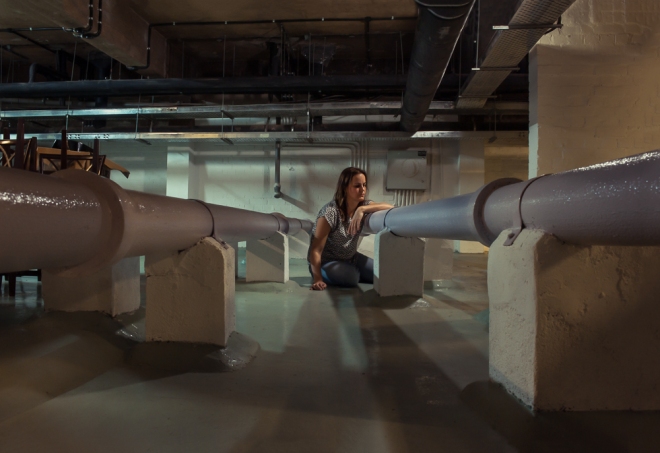



















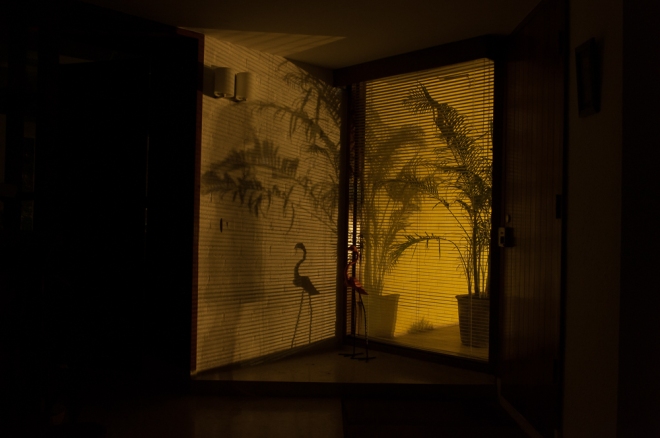
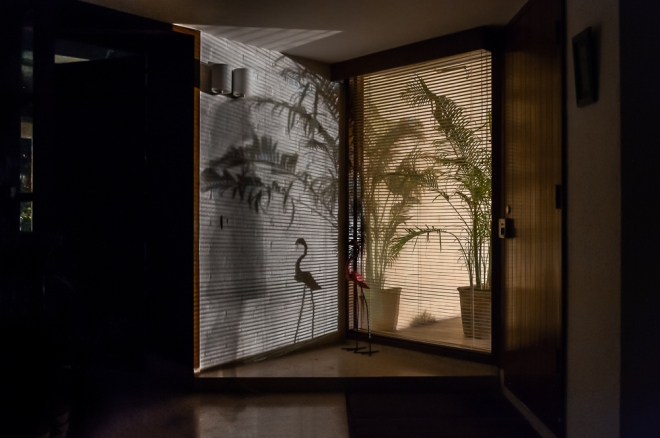 As you can see I have lightened the shadows quite a bit, changed the colour cast and added a lot of contrast and clarity. I have purposely left the left side lighter, to let the eye wonder through the image and get clues about where and how it was taken. Because I look more like a shadow than the actual being, I get a ghost like appearance. Together with the guy’s face in the plants and the flamingo the entire scene is a bit surrealistic and full of visual clues, which I like.
As you can see I have lightened the shadows quite a bit, changed the colour cast and added a lot of contrast and clarity. I have purposely left the left side lighter, to let the eye wonder through the image and get clues about where and how it was taken. Because I look more like a shadow than the actual being, I get a ghost like appearance. Together with the guy’s face in the plants and the flamingo the entire scene is a bit surrealistic and full of visual clues, which I like.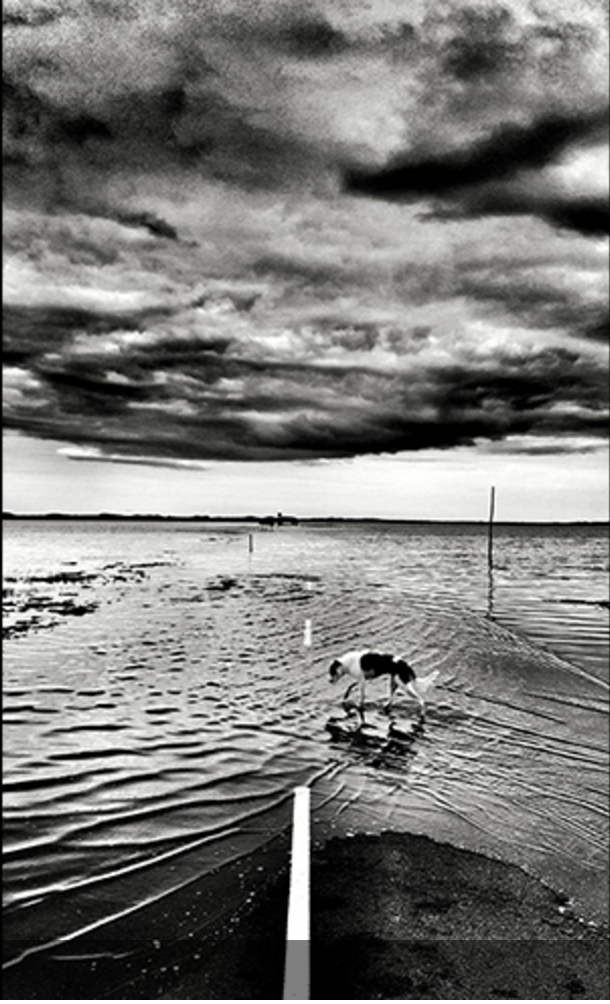
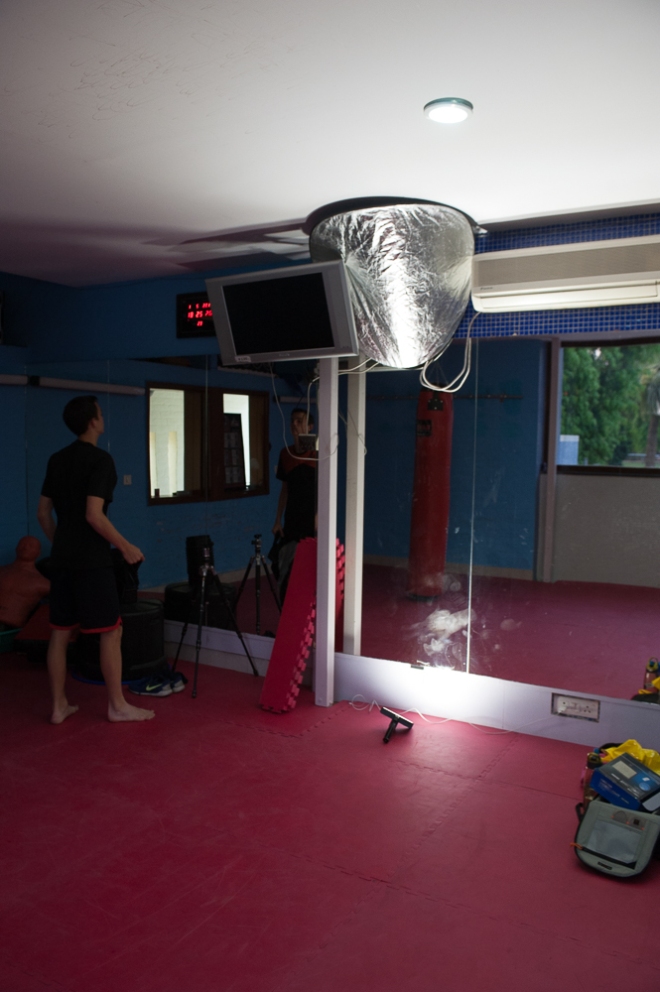
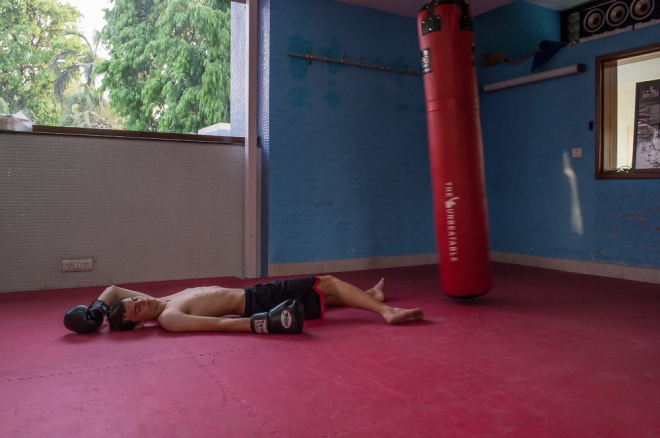
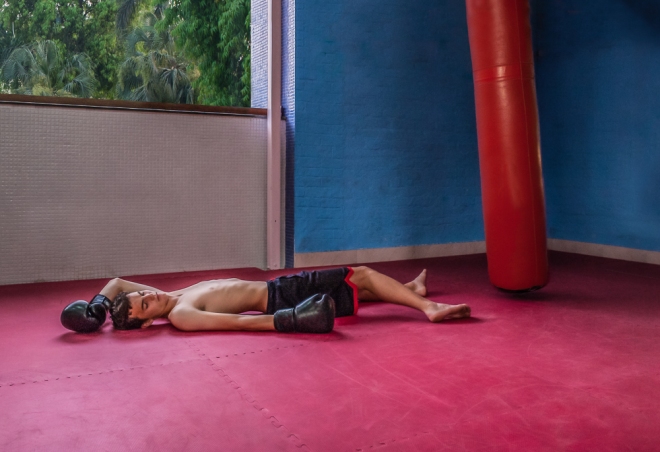 This is not the image I’m going to send in, although I do like the colour scheme and think there is potential to get a better shot in this setting and with this idea. However, I’m not happy with the composition and it is a bit over photoshopped. Besides that, I have not really executed it according to a plan, nor drawn up the scene etc, but it is just good to be working and thinking. I now know that I should pay more attention to get the lighting right when taking the photograph, because this one had way too much noise. Next time I am also going to draw things out. My head is already spinning with ideas, bring it on
This is not the image I’m going to send in, although I do like the colour scheme and think there is potential to get a better shot in this setting and with this idea. However, I’m not happy with the composition and it is a bit over photoshopped. Besides that, I have not really executed it according to a plan, nor drawn up the scene etc, but it is just good to be working and thinking. I now know that I should pay more attention to get the lighting right when taking the photograph, because this one had way too much noise. Next time I am also going to draw things out. My head is already spinning with ideas, bring it on